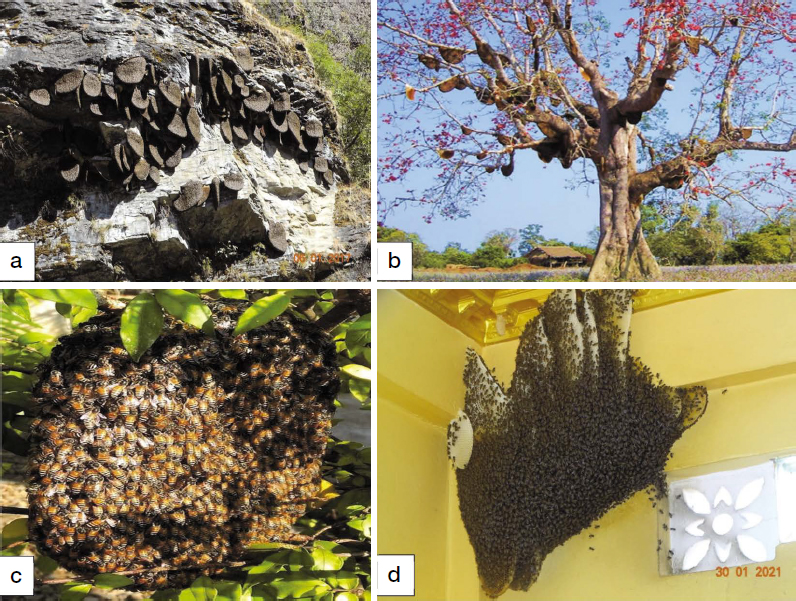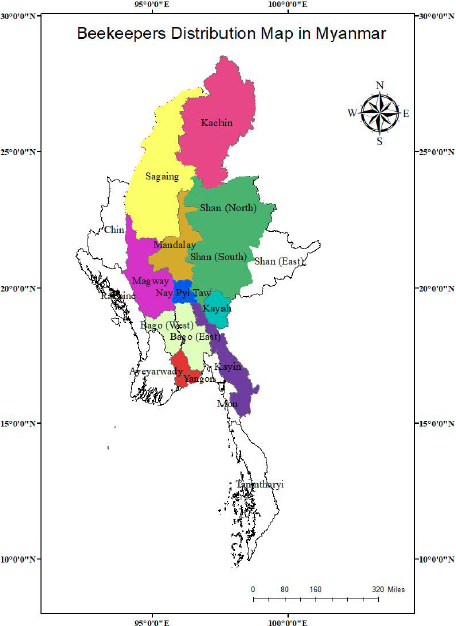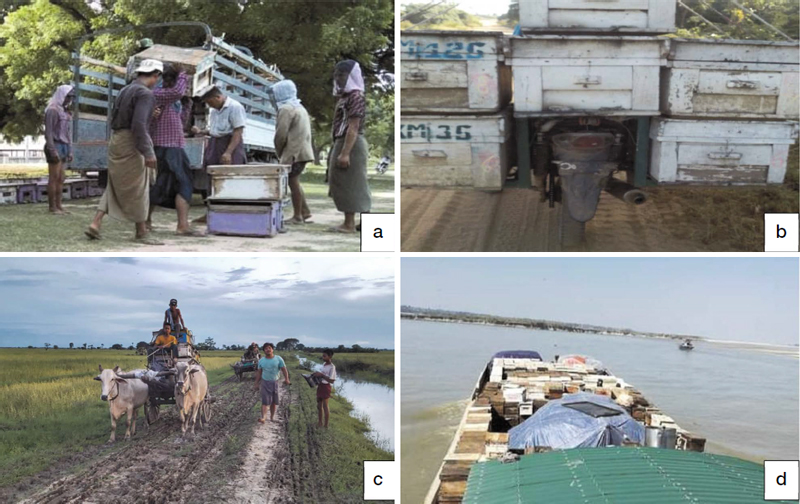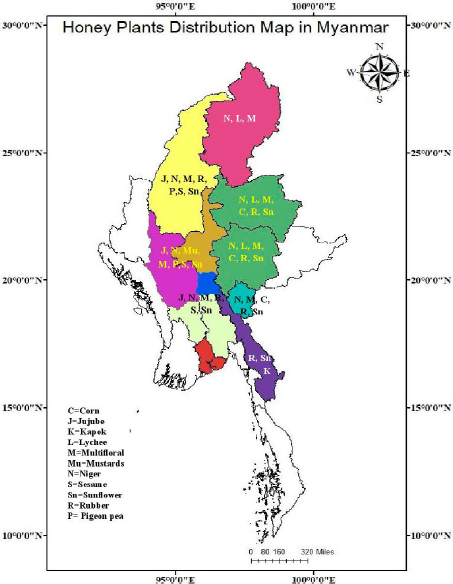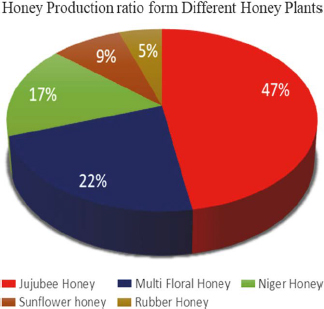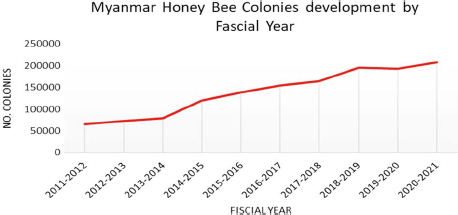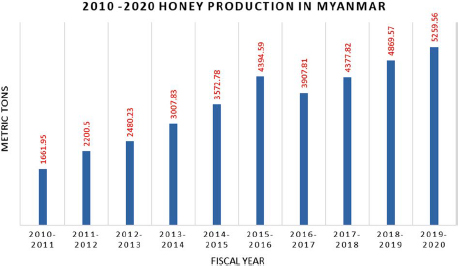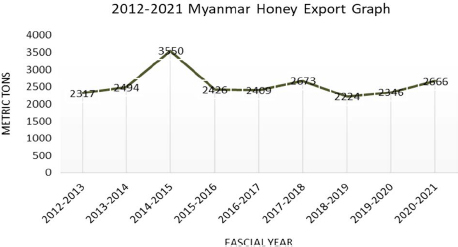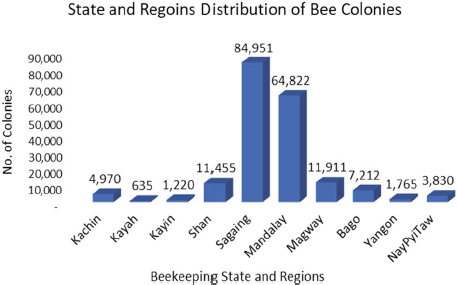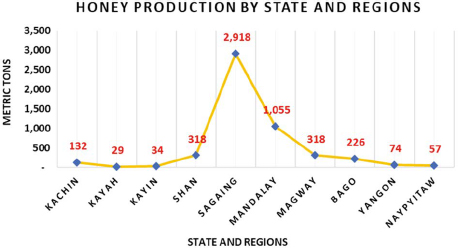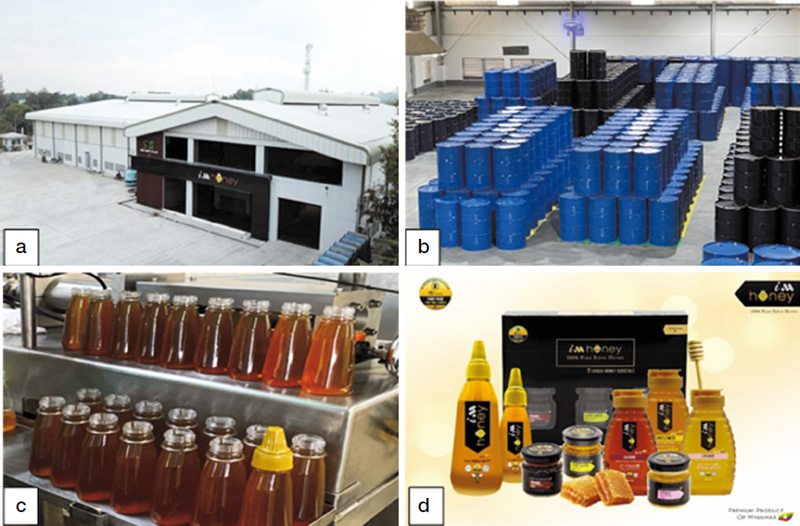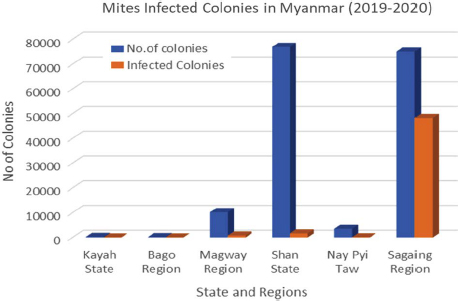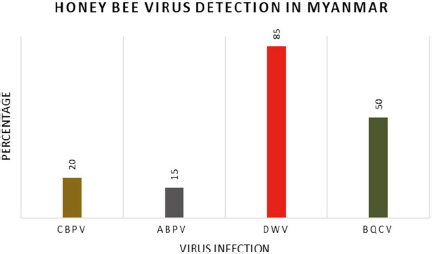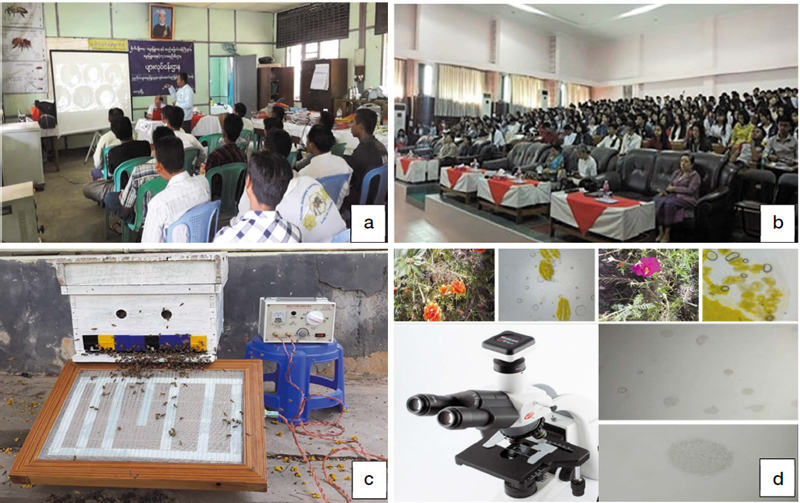
A Review of Current Beekeeping Status in Myanmar
Abstract
Beekeeping in Myanmar began with traditional beekeeping, and modern Apis mellifera beekeeping was introduced in 1979. In ten States and Regions, commercial beekeeping for A. mellifera is practiced, as well as wild beekeeping for Apis cerana, wild bee hunting for Apis dorsata, Apis laboriosa, and wild bee harvesting for Apis florea. Wild bees and small-scale beekeeping are found in five other states and regions. A total of 5,000 Metric Tons of honey are produced annually. The cost of 1 kg of honey is between 4,500 and 5,000 MMK (2 USD). For A. mellifera honey, the price per metric ton is between 1,800 and 2,000 US dollars. There are five basic categories of honey, including multifloral, rubber, Niger, sunflower, and jujube honey. From the regions of Mandalay, Sagaing, and Magway, special Jujube honey is produced. from the regions of Sagaing and Mandalay, sunflower honey. Niger Honey from Shan, Kachin, and the Sagaing Region. Rubber honey from the Kayin, Mon, and Bago states. In Myanmar, there are 200,000 bee colonies, comprising old-fashioned and contemporary hives. The black queen cell virus diseases, deform wing virus diseases, acute bee paralysis virus diseases, varroa mites infection, and tropilaelaps mites infection are the most prevalent illnesses and pests for the beekeeping industries in Myanmar.
Keywords:
Honeybees, Mites, Virus, Bee industry, MyanmarINTRODUCTION
The world beekeeping industry has been developing year by year. The world of beekeeping was developed by regions such as the Americas, Europe, Africa, Australasia, and Asia (Chantawannakul and Ramsey, 2018). Western countries have developed Apis mellifera L. beekeeping, and Eastern countries, especially Asian countries, have developed native honeybee species such as Apis cerana F. keeping and A. mellifera keeping (Oldroyd and Wongsiri, 2009). In China, the beekeeping industry has about 6,000,000 A. mellifera colonies and approximately 2,000,000 A. cerana colonies and produces about 450,000 metric tons of honey per year (Zheng et al., 2018). Russia beekeeping industry has 3,093,800 colonies, and honey production is 65,006 metric tons (Zalilova et al., 2021). India beekeeping industry has approximately 1,500,000 colonies and produces 55,000 metric tons per year (Kishan Tej et al., 2017). In the beekeeping sector of Vietnam, there are 1,500,000 A. mellifera and A. cerana colonies and 48,000 metric tons of honey (Thai and Van Toan, 2018). Korea has 2,581,766 A. mellifera colonies and 98,076 A. cerana colonies, and the honey production is approximately 30,000 metric tons per year (KBA, 2023). According to the A. mellifera beekeeping development report of Japan, 200,000 honeybee colonies are kept, and around 80,000 colonies are being used for pollination of greenhouse horticulture such as strawberries (Yoshiyama and Kimura, 2018). The A. mellifera beekeeping development in Thailand has about 300,000 colonies and 12,660 metric tons (Chantawannakul, 2018). Asian countries’ production of honey is gradually increasing.
BACKGROUND HISTORY OF BEEKEEPING IN MYANMAR
The Republic of the Union of Myanmar, also known as Burma, is in Southeast Asia. It is situated between north latitudes 9° and 29° and east longitudes 92° and 102°. It is the largest country area in Mainland Southeast Asia. It is bordered to the northwest by Bangladesh and India; to the northeast by China; to the east and southeast by Laos and Thailand; and to the south and southwest by the Andaman Sea and the Bay of Bengal. Honeybee species are diverse in Myanmar. There are five of the eight known indigenous species, such as A. cerana, A. dorsata, A. laboriosa, A. florea, and A. andreniformis. Among the indigenous species, only A. cerana was kept in log hives, pots, and modern hives. A. dorsata, A. laboriosa, and A. florea are natural wild bees for honey production; bee hunters collect the honey from the forest. Nowadays, A. andreniformis is very rare to find in Myanmar. A. mellifera beekeeping was used in two different types: standard Langstroth achives and Taiwanese hives. All box hives are made of wood, especially teak. A. cerana is usually kept in mountainous and forest areas. A. mellifera is usually kept in wildflower honey resources and agricultural crop fields (Morse, 1982; Nyein, 1984). Myanmar has practiced traditional A. cerana beekeeping since the 10th century. A. cerana species were distributed all over the country. Beekeepers keep A. cerana by providing natural habitats for the bees, such as wooden boxes, hollow tree trunks, clay ports, bamboo stems, buckets, and crocks. This kind of traditional keeping is still used in Kachin State, Kayin State, and Shan State. Systematic research for A. cerana beekeeping started in 1982 (Nyein, 1984). Wild bee colonies were found on cliffs, trees, buildings, and other places. Beekeepers harvest the combs of A. cerana, A. dorsata, A. florea, and A. laboriosa to make wild honey or natural honey (Fig. 1). This method produces a significant amount of honey, which is used for local consumption. In Myanmar, some places have traditional keeping and harvesting practices for A. dorsata and A. cerana species. Most of A. dorsata species can be found in many places in Myanmar, especially in Sagaing Region, Kachin State, Kayin State, Chin State, and Ayawady Region. Mostly, these species can be found in the biggest forest called Maha Myaing Taw near Kalaywa Township. The world’s largest honeybee, A. laboriosa species, was also found near Bontala Waterfall in the village tract of Htee Saung, Matupi township, which is located on the Mountain Belt of Chin State. A. dorsata and A. laboriosa species nests can be seen on the escarpment, precipice, and at the edge of the ceiling of the building. These giant honeybee species couldn’t be used for beekeeping because they were threatening and endangering species for humans (Hlaing et al., 2020a). The UNDP and the Ministry of Agriculture and Forestry of Burma (Myanmar) began introducing a tropical beekeeping program in Myanmar in 1979. The first imports of European honeybee colonies were 590 packages from Australia and the US. In 1980-1981, the Myanmar government sent 50 trainees to study beekeeping technology from different countries, such as the US, Australia, England, Israel, France, and Japan. In the years 2020-2021, the number of beekeepers became 835 and commercial honeybee colonies was estimated at about 200,000 (ADD, 2021).
COMMERCIAL BEEKEEPING IN MYANMAR
Nowadays, A. mellifera beekeeping is commercial beekeeping in Myanmar. Some beekeepers keep A. cerana in specific areas. The mellifera beekeepers used to migrate beekeeping around the country according to the blooming seasons of honey plants. There are 835 beekeepers recorded (Table 1) from 10 different states and regions (Fig. 2) (ADD, 2021). From September through March, Myanmar has a long honey production season. There are five primary types of commercial honey production: multi-floral honey, Jujube honey, Niger honey, and sunflower honey. The timing is perfect for Myanmar’s beekeepers to control bee health and produce honey successfully. The beekeepers are under the guidance and supervision of the Apiculture Development Division (ADD), Livestock Breeding and Veterinary Department (LBVD), and Ministry of Agriculture, Livestock, and Irrigation (MoALI). ADD is responsible for Myanmar’s beekeeping sector development, and they provide support to beekeepers, a basic beekeeping training course, and a beekeeper license. Myanmar Apicultural Association (MAA) support to beekeeping association and honeybee products distributors.
BEEKEEPING ECONOMY IN MYANMAR
A. cerana, A. florea, and A. dorsata honeys are specifically produced in Myanmar from various regions throughout the nation. A. cerana is a wild honeybee with dominant swarming behaviors in Asian honeybees. Therefore, A. cerana is kept in villages near the forest area, especially Laik Tho Town and Thandaunggyi Township, between the Kayin State and Bago regions. There is a huge forest area, which is the most suitable environment for wild bees such as A. dorsata and A. florea. In the Laik Tho Gyi Village Tract, there is a traditional beekeeping business with A. cerana keeping and hunting for A. dorsata honey. In this village area, more than 1,000 A. cerana colonies are maintained and produce 300 kg of A. cerana honey annually. Bee hunters also collect 150 kg of A. dorsata honey. There are 5 villages, such as Myauk Pe Boe Village, Thin Baw Taw Village, Kyauk Phyar Village, Nann Cho Village, and Thet Nu Khone Village, athat engage in traditional beekeeping, and this region produces an average of 300 metric tons of honey per year; almost all the honey is organic (Hlaing et al., 2018). Another significant A. cerana keeping area is Htein Chaung Village, Katalu Village tract, and Kyun Su Township. The main town of Kyun Su is located on the north-east coast of Kanmaw Island, southwest of Myeik City (Hlaing et al., 2019). Beekeepers in Myanmar practice migratory beekeeping, and A. mellifera is used for commercial beekeeping. As a result, beekeepers travel across the country using a variety of transportation methods. Trucks were typically used to transport their bee colonies. Commercial beekeepers maintain approximately 3,000 colonies, whereas small-scale beekeepers maintain 50 to 500 or 1,000. Beekeepers used motorbikes, compact cars, and cattle carts to move honeybee colonies locally, whereas state and regional transit systems that are on the main route can use massive trucks. The only way to cross the river was by ship (Fig. 3). Beekeepers have predetermined timeframes for colony preparation and migration. From April to July, which is the sesame flowering season, beekeepers prepare for disease prevention and treatment, re-queening, colony development, and management of new colonies. During the months of July and August, when maze (corn) is in bloom, beekeepers start new bee colonies. Beekeepers relocate to jujube blossoming regions from September to October, which is the jujube blooming season. Some beekeepers relocate to regions with thriving sesame, Niger, canola, and sunflower crops after the jujube season, which runs from November through December. From January to March, some beekeepers visit regions where kapok, sunflowers, and wildflowers are in bloom.
HONEY PRODUCTION FROM MAIN HONEY PLANTS IN MYANMAR
Myanmar has established 34 townships in 10 states and regions for the development of honey beekeeping stations under the direction of the Livestock Breeding and Veterinary Department (LVBD). The distribution of honey plants varies depending on elevation and rainfall, so beekeepers migrate with the flowering seasons and honey plants in Myanmar. Most beekeeper migration states and regions are Kachin, Kayah, Kayin, Shan, Sagaing, Mandalay, Magway, Yangon, Bago, and Nay Pyi Taw (Fig. 4). The conditions for Myanmar honey production are dependent on the bee plants; typical yields of honey are Jujubee Honey (47.30%), Multi Floral Honey (22.40%), Niger Honey (16.60%), Sunflower Honey (8.50%), and Rubber Honey (5.20%) (Fig. 5). Myanmar beekeeping sector development increased year by year, within 10 years between 2011 and 2021 (Fig. 6). And the production of honey also increased by approximately 5,500 metric tons (Fig. 7). Myanmar honey is exported to Japan, China, Thailand, Singapore, South Korea, and the United States. In 2021, Myanmar exported honey about 2,666 metric tons (Fig. 8). The export price of honey is 2,000 USD for 1 metric ton (ADD, 2023; Htwe, 2023). In Myanmar, local honey consumption is about 55% of total honey production, and 45% is exported. Honey distributors and Honey Exporters, obtain their honey supply from several beekeeping sources. Jujube honey, Niger honey, sunflower, wild sunflower, sesame, and rubber honey are the common export varieties of honey (ADD, 2023).
By a local lab and an internationally accredited lab in accordance with export countries, the constituents fructose, glucose, sucrose, and pH were evaluated. For export to the US, Germany and Canada must send Intertek or Quality Services International (QSI) from Germany, and exports from Japan must send Japan Labs (Htwe, 2023). The normal result of Myanmar honey quality is shown in Table 2.
HONEYBEE POLLINATION PROCESS
Honeybees were used to pollinate horticultural and agricultural plants. Commercial pollination services are used by jujube farms, sesame farms, sunflower farms, rubber plantations, watermelon farms, avocado plantations, orange tree plantations, and mango tree plantations. To pollinate crops on fields where seeds were produced, farmers rented bee colonies (Fig. 9). There are 200 or more different species of honey plants in Myanmar. The most common agricultural plants that generate honey are listed in Table 3 (Hlaing et al., 2020b).
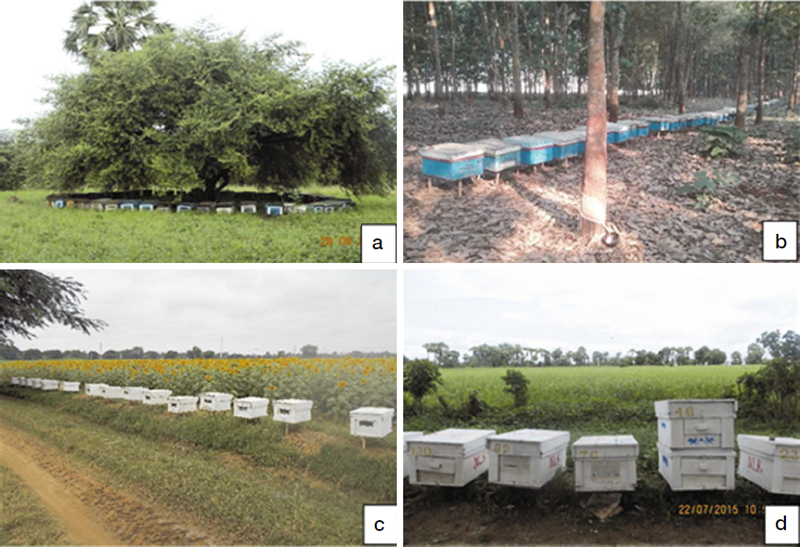
(a) Jujube pollination, (b) Rubber pollination, (c) Sunflower pollination, and (d) Sesame pollination (photo by Dr. Hlaing MinOo, and ADD).
STATE AND REGIONAL HONEY PRODUCTION
Myanmar will have 835 registered commercial beekeepers in 2022, with a total of 192,771 bee colonies. Among the States and Regions in Myanmar, Sagaing Region has the largest number of bee colonies 84,951 and honey production of 2,918 metric tons (MT) per year, followed by Mandalay Region in the second place with 64,822 colonies and honey production of 1,055 MT per year, and Magway Region in the third position with 11,911 colonies and honey production of 318 MT per year (Fig. 10). Other states and regions, such as Chin State, Mon State, Rakhine States, Ayeyarwady Region, and Tanintharyi Regions, have small-scale production of honey from wild bees. These states and regions have heavy rains, long coasts, mountain belts, and heavy windy areas. Therefore, migration beekeeping in these states and regions are very difficult, and only small-scale honey production from wild bees (Fig. 11).
TRADITIONAL AND COMMERCIAL HONEY MARKET
46% of honey production is consumed locally, primarily for medicinal and dietary supplement purposes. Most beekeepers sell honey in Viss (1 Viss=1.68 kg). Honey exporters, Honey distributors, manufacturers, and merchants primarily package raw honey in plastic and glass bottles. The majority of honey merchants package honey themselves and sell it under their own brand name. A box comprises 12 large honey bottles or 24 small honey bottles. Some small businesses sell their honey without packaging and in the quantities desired by the consumer. Some honey exporters have their own honey purification and filtering factory and make finished items in a variety of container sizes, according to export and local markets. Companies prepared the containers in a variety of sizes, including 200 mL, 300 mL, 360 mL, 400 mL, 420 mL, 500 mL, 550 mL, 750 mL, 800 mL, 1,000 mL, 1,500 mL, and 300 kg iron drum packaging (Fig. 12). Some local markets sell raw honey and honeycombs.
HONEYBEE DISEASES AND BEE PESTS
Since 1979, the first introduction of European honeybees to Myanmar has been infected by Sac brood virus diseases (Morse, 1982). There were two mite species that infected Myanmar honeybee colonies: Tropilaelaps in 1992 and Varroa in 1999. Heavy varroa mite infestations and an outbreak occurred in Myanmar in 2019-2020 (DOA, 2022) (Fig. 13). In the Myanmar beekeeping industry, the most common infected honeybee viruses are deform wing virus (DWV), acute bee paralysis virus (ABPV), chronic bee virus (CBPV), and black queen cell virus (BQCV) (Hlaing et al., 2020c) (Fig. 14).
HONEYBEES AND POLLINATOR EDUCATION IN MYANMAR
Myanmar has different species of Asian bees, European honeybees, and stingless bees. Since 1981, Myanmar beekeeping has been established by the Ministry of Agriculture and Forestry. The Department of Apiculture (DOA) plays the main role in beekeeping development in Myanmar. After 2007, DOA was moved under the control of LBVD, the Ministry of Livestock and Fisheries. The duty and responsibility of DOA are to provide basic and advanced beekeeping training for beekeepers and issue authorized certifications for dealers and exporters. Honeybee education for higher education was started in 2015 at the University of Veterinary Science (UVS), Yezin, Nay Pyi Taw. UVS helps with beekeeping extension, honeybee research, database development, and collaboration with the Myanmar Apicultural Association and Division of Apiculture for the development of the Myanmar Beekeeping Industries (Fig. 15).
Acknowledgments
The authors would like to thank the Korea Rural Development Administration Alumni Association (KoRAA), the Rural Development Administration (RDA). Additionally, thanks to the assistance of the Division of Apiculture, the Laboratory of Honeybee Breeding, and the National Institute of Agriculture Sciences (NIAS) in the Republic of Korea. We also thank the Ministry of Agriculture, Livestock, and Irrigations, Republic of the Union of Myanmar, and the Myanmar-Korea Rural Development Administration Alumni Association (Myan KoRAA). And, thanks to the Rector and staff from the University of Veterinary Science, Yezin, Nay Pyi Taw. Additional appreciation goes out to the Director and Staff from the Division of Apiculture, Livestock Breeding, and Veterinary Department. For their gracious assistance in providing data and information for the Myanmar Beekeeping industry, we thank the President and members of the Myanmar Apicultural Association. This study is part of the “2023 KoRAA Long-Term Training Program” of Rural Development Administration, Republic of Korea.
References
- ADD. 2021. Honeybee Keeping and Bee Products Flyer.
- ADD. 2022. Bee colonies migration and honey plant calendars departmental report.
- ADD. 2023. The development of beekeeping sectors report.
-
Chantawannakul, P. 2018. Bee diversity and status of beekeeping in Thailand. Asian Beekeeping in the 21st Century, 269-285.
[https://doi.org/10.1007/978-981-10-8222-1_12]

-
Chantawannakul, P. and S. Ramsey. 2018. The overview of honeybee diversity and health status in Asia. Asian Beekeeping in the 21st Century, 1-39.
[https://doi.org/10.1007/978-981-10-8222-1_1]

- DOA. 2022. Bees Diseases Record in Myanmar. Departmental Report.
- Hlaing, M., H. SanSan, T. ChoThant, S. L. Kyaw and K. WinOhmar. 2019. Traditional keeping survey on Apis cerana keeping in Kyunsu. Departmental research. University of Veterinary Science, Yezin, Nay Pyi Taw, Myanmar.
- Hlaing, M., H. SanSan, T. ChoThant, S. L. Kyaw and K. WinOhmar. 2020a. The Current Beekeeping Condition in the Republic of the Union of Myanmar. COLOSS Asia conference, Chiang Mai, Thailand, PP-20.
- Hlaing, M., H. SanSan, T. ChoThant, S. L. Kyaw and K. WinOhmar. 2020b. Survey to Beekeeper migration on honey flows seasons. Departmental Research, University of Veterinary Science, Yezin, Nay Pyi Taw, Myanmar.
- Hlaing, M., H. SanSan, S. L. Kyaw and K. WinOhmar. 2020c. Honeybee Virus Diseases in Myanmar. Departmental Research, University of Veterinary Science, Yezin, Nay Pyi Taw, Myanmar.
- Hlaing, M., T. ChoThant, S. L. Kyaw and K. WinOhmar. 2018. Beekeeper Survey for traditional beekeeping in Myanmar. Departmental research University of Veterinary Science, Yezin Nay Pyi Taw, Myanmar.
- Htwe, A. K. 2023. Analysis Results by Honey Type of Myanmar, Myanmar Apicultural Association.
- KBA. 2023. Beekeeping Industry Information by Korea Beekeeping Association.
-
Kishan Tej, M., R. Aruna, G. Mishra and M. Srinivasan. 2017. Beekeeping in India. Industrial Entomology, 35-66.
[https://doi.org/10.1007/978-981-10-3304-9_3]

- Morse, R. A. 1982. The beekeeping program in Burma. Glean. Bee Cult. 110(454): 455-467.
- Nyein, M. M. 1984. Study of Traditional methods of keeping Indian Bees in Burma and Keeping with modern method. Bureau of life Science Seminar Burma Research Association 1984: 1-9.
-
Oldroyd, B. P. and S. Wongsiri. 2009. Asian honeybees: biology, conservation, and human interactions: Harvard University Press.
[https://doi.org/10.2307/j.ctv2drhcfb]

-
Thai, P. H. and T. Van Toan. 2018. Beekeeping in Vietnam. Asian Beekeeping in the 21st Century, 247-267.
[https://doi.org/10.1007/978-981-10-8222-1_11]

-
Yoshiyama, M. and K. Kimura. 2018. Bee diversity and status of beekeeping in Japan. Asian Beekeeping in the 21st Century, 223-245.
[https://doi.org/10.1007/978-981-10-8222-1_10]

-
Zalilova, Z. A., A. G. Mannapov, M. T. Lukyanova and V. A. Kovshov. 2021. Strategies of regional economic and sustainable development: The case of the beekeeping industry. In The Challenge of Sustainability in Agricultural Systems: Volume (1), 855-862.
[https://doi.org/10.1007/978-3-030-73097-0_95]

-
Zheng, H., L. Cao, S. Huang, P. Neumann and F. Hu. 2018. Current status of the beekeeping industry in China. Asian Beekeeping in the 21st Century, 129-158.
[https://doi.org/10.1007/978-981-10-8222-1_6]

